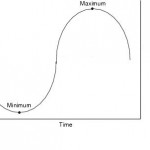 Let’s assume you want to find the minimum and/or maximum of a column of numbers in a given file using AWK.
Let’s assume you want to find the minimum and/or maximum of a column of numbers in a given file using AWK.
Assume we have an input file foo with f.ex. line number in first column and in the second ($2) and third column ($3 in awk) we have the values of interest.
File: foo
1 2 40
2 3 23
3 15 -12
4 8 -1
5 11 0
Use the following awk commando find minimum and maximum of the columns of interest:
awk ‘NR == 1 {max=$2 ; min=$2} $2 >= max {max = $2} $2 <= min {min = $2} END { print "Min: "min,"Max: "max }' foo
or
awk ‘BEGIN{ max = -999999999 ; min = 9999999999 } $2 > max {max = $2} $2 < min {min = $2} END{ print "Min: ",min, "Max: ",max }' foo
The result will be for column 2:
Min: 2 Max: 15
and for column 3:
Min: -12 Max: 40
Standard deviation
Here you may see how to calculate the standard deviation using AWK.
Average or arithmetic mean
Here you may see how to calculate the average or arithmetic mean using AWK.


